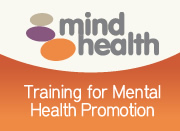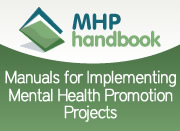Tools
- Utilities:
- Print this page
- Send this page
- Font size:
- Increase font size
- Decrease font size
Browse Database
Login, so as to add your own items.
-
Depressed Little Prince
22/12/2008
Depressed Little Prince is an interactive web-site that aims to educate people on depression and its treatment, encourage early helpseeking and aims to reduce the stigma of depression. It provides instructions how to recognise oneś own depression and a depressed intimate/friend; how to react and where to refer. The web-site has very nice design and visitors are taken to a journey in order to create accurate understanding of depression. Settings: Education
MHP Steps: Preparation | Implementation | Needs Analysis -
LivingWorks
22/12/2008
LivingWorks is dedicated to enhancing suicide intervention skills at the community level, and committed to making its suicide prevention training programs widely available, cost effective, interactive and easy to learn, with practical applications designed for all types of caregivers. The LivingWorks objective is to register qualified trainers in local communities, who in turn can prepare front-line gatekeepers with the confidence and competence to apply first aid suicide intervention in times of individual and family crises. Learning experiences are interactive, practical, regularly updated and customizable and suitable for everyone who wants to help. Settings: Education
MHP Steps: Preparation | Implementation | Needs Analysis -
Questionnaire of Occupational Burdens in Teaching (QOBT)
29/07/2008
The qustionnaire measures occupational burdens in three aspects: 1. Conflict Situations – CS - (9 items). This subscale includes all kinds of behavior presented by students and their families or colleagues that have the negative emotion factor. Particularly important are the situations where conflict or aggression occur, The sample items: My students treat me in a vulgar way, Quarrels between me and my superiors occur, Quarrels between me and families of my students occur. 2. Organizational Burdens - OB - (8 items). This subscale involves the burdens in a macro (system) scale (e.g. low salary over changing law) and the burdens at organizational level (poor management, lack of autonomy). The sample items: Curricula and educational plans are overloaded, My superiors do not support me, The quality of office premises is poor. 3. Lack of Work Sense – LWS - (3 items). In this subscale there are rarely operationalized burdens linked with lack of work sense feeling. The items included in this subscale are: It is hard to help my students although I want it, Despite my efforts my client do not learn what they are supposed to learn, I have to wait long for the positive changes in the behavior of my students Those three factors (subscales) sum up to 48,88% of global variance. The level of reliability is very satisfactory. Cronbach α i Guttman reliability or each subscale look as follow: Conflict Situations (0,85; 0,79), Organizational Burdens (0, 79; 0, 89), Lack of Work Sense (0,69). The new tool proved to be valid. There are reverse correlations with the self efficacy . and positive correlations with burnout that can be treated as the results of prolonging or high stress. There are also temporary norms for the Questionnaire for Occupational Burdens in Teaching (also separate for men and women) Preparation of the tool was co-financed by the University of Lodz grant No. 504/487 Settings: Workplace -
Beyond Blue Schools Intervention
11/06/2008
The beyondblue schools Intervention was developed collaboratively by the University of Queensland, the Victorian Centre for Adolescent Health, the South Australian Department of Education and Children's Services and beyondblue. It draws on national and international research and the groundbreaking work conducted with schools in Australia in the past decade. The intervention aims to buffer the effects of adverse life events by building protective factors within the individual, through the teaching of life skills, and within the environment by enhancing the capacity of schools to provide a supportive and safe environment. Settings: Education
MHP Steps: Follow Up | Implementation | Needs Analysis -
Eyes on Bullying: What Can You Do?
11/06/2008
Successful bullying prevention includes education, preparation, and teamwork. This toolkit provides specific insights, strategies, activities, and resources to address bullying. It is designed especially for caregivers and parents of preschool and school-age children and youth to use in child care programs, afterschool and youth programs, and camps. Settings: Education -
Behaviour and Attendance Toolkit Units
11/06/2008
These Toolkit units provide consultants and schools with a comprehensive resource that supports post audit action plans. There are ten units within the toolkit including: Leadership and Management / Everyday policies / Dealing with consistently poor behaviour / Bullying / Pupil Support Systems / Classroom Behaviour / Out of class behaviour / Attendance / Links with partners and other agencies. Settings: Education -
Work Positive Benchmarking Tool
30/05/2008
Benchmarking tool for examining where your organisation stands in relation to the HSE (Health Safety Executive - UK) management standards for work related stress Settings: Workplace
MHP Steps: Needs Analysis -
Improving Services and Support for Older People with Mental Health Problems
30/05/2008
This is the second and final report of the UK Inquiry into Mental Health and Well-Being in Later Life. The Inquiry was launched in late 2003 as a result of concern that mental health in later life is a much neglected area. It sets out to illustrate how can we improve services and support for older people with mental health problems. Settings: Residence for Older People
MHP Steps: Preparation | Needs Analysis -
Healthy Workplace Strategies: Creating Change and Achieving Results
29/05/2008
This report focuses on the organizational change processes, strategies and tactics that can bring about a healthier and more productive working environment. It emphasises that successful interventions must target underlying work practice and organizational factors. The report offers the 'action model' to help you achieve healthier organizations. Settings: Workplace
MHP Steps: Needs Analysis -
Comprehensive Workplace Health Promotion: Recommended and Promising Practices for Situational Assessment Tools
29/05/2008
This resource is designed to help workplace health promotion intermediaries (in Ontario) to: * Select and implement a situational assessment tool in their workplace, and * Replicate and/or adapt the best practice process and methodology used to generate the tools. It contains detailed information about 29 recommended and promising tools in six categories: needs assessments, health risk appraisals, workplace environmental audits, employee interest surveys, current practice surveys, and organizational culture surveys. Settings: Workplace
MHP Steps: Follow Up | Needs Analysis



